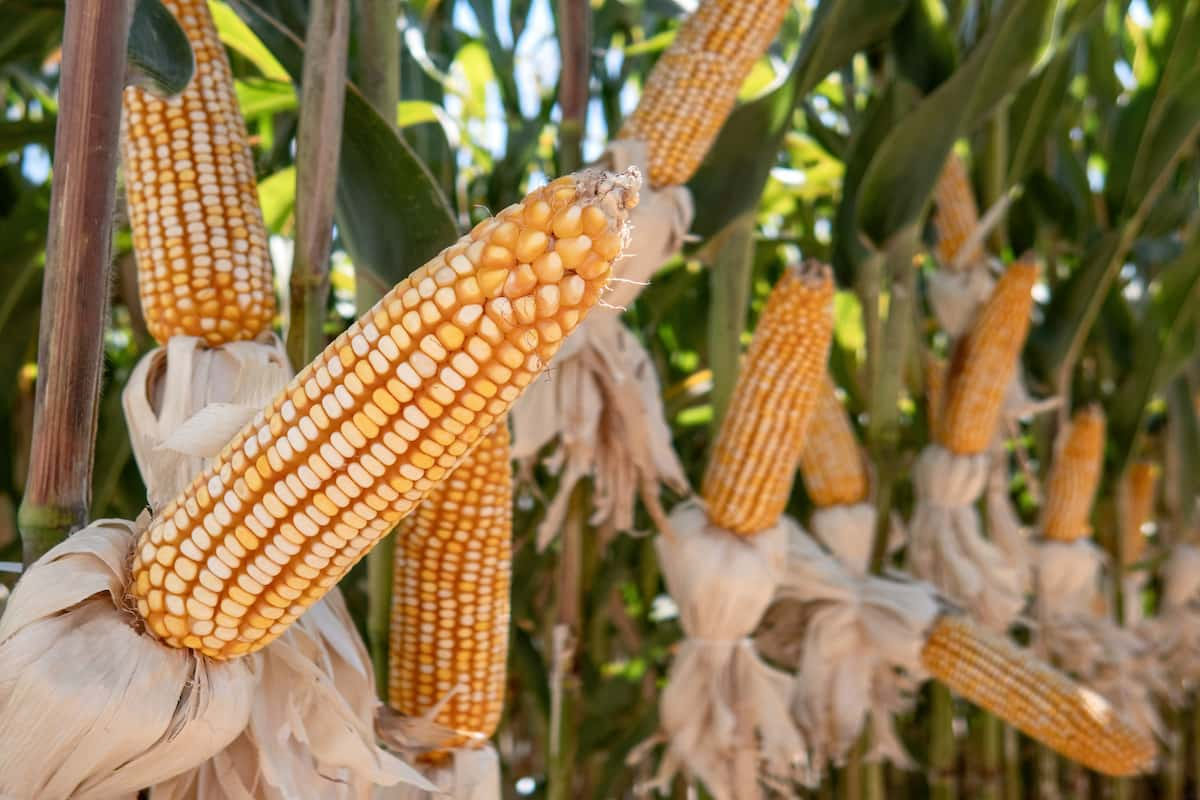The productivity of maize mainly depends on the crop’s nutrient management. For maize to be more productive, plant nutrients must be provided adequately and balanced. Among the primary sources of plant nutrients, chemical fertilizers are the most important. Chemical fertilizers have undoubtedly boosted crop growth and yield, but to a great extent, these have resulted in deteriorating soil physical, chemical, and biological conditions.

As a result of using organic and inorganic fertilizers together, crop yields are increased, and the soil’s physical, chemical, and biological conditions are maintained. The highest productivity of crops can be achieved by combining organic manures with inorganic fertilizers. Economic yield can be maximized by using inorganic fertilizers and biofertilizers. Identifying the best type of organic manure and the best combination of organic and inorganic fertilizers.
Maximising the Maize/Corn Yield
Role Of Major Nutrient Elements In Maize/Corn Crop
Basal Fertilization – Starting with Phosphorus
- During the initial stages of root development, Phosphorus is the only nutrient that is absolutely necessary, so corn producers usually utilize the entire P and small amounts of Nitrogen and Potassium as basal fertilizer.
- Applying large amounts of K or N at this stage may cause significant problems. A starter band should not contain urea and diammonium phosphate (DAP) to eliminate the risk of seedling injury.
Nitrogen – The Plant Needs Most of it Later
- In terms of nitrogen usage, corn is considered to be a heavy user. Plants require different amounts of Nitrogen at different stages of their growth.
- The plant’s growth rate and yield are regulated by Nitrogen, which is an essential element for the crop.
- Adding Nitrogen to crops at different times will depend on their needs. As a result of this split application method, Nitrogen is less likely to be lost due to wet weather before the crop can absorb it.
- A maximum of one-third of the total Nitrogen should be applied near planting/crop emergence. About 30 days later, the remaining Nitrogen can be applied.
- Early fertilization can waste much Nitrogen if there is long, wet weather before rapid corn growth begins. Saturated soil loses Nitrogen mostly through denitrification, especially in heavy clay soils.
Potassium
- For sustainably good yields, corn also needs potassium. You may not need to provide additional potassium to your crops since only 25% of the absorbed K is stored in the kernels.
- The remaining 75% returns to the soil through the remaining integration. You may need to apply additional amounts if you harvest the entire plant (silage harvest).
- In heavily manured cornfields, potassium can accumulate very rapidly. To prevent salt injury, starter N+K2O should be limited in the fertilizer band if K is needed.
- Unlike Phosphorus, potassium is relatively immobile in most soils, so it is best applied in the fall.
Zinc and Iron
- Zinc availability decreases as soil pH increases, and most zinc deficiencies are reported in soils with pH levels above 7.0.
- Soils with high levels of free lime and soils leveled for irrigation are likely to have zinc deficiencies.
- Adding manure to these exposed subsoils may correct Zn deficiencies and improve soil structure.
- Corn production is adequately supplied with iron (Fe) from most soils, although the availability of Fe decreases with soil pH.
- Soil with a pH above 7.8 or one leveled for irrigation and exposed to the subsoil is more likely to suffer from iron deficiencies.
- Yellow striping of younger leaves is a visual symptom of Fe deficiency.
Foliar Fertilization for N and K
- In addition to soil fertilization, foliar applications can also promote grain development. Many corn farmers have reported using 13-3-44 between the 7-9 leaf stage and three weeks later.
- Approximately 200 liters of water are sprayed per hectare, with a concentration of about 2%. Obviously, these are just some common patterns you should not follow without researching first.
In case you missed it: Nutrients of Vermicompost: Explained with Simple Steps

Recommended Integrated Nutrient Management Practices in Maize/Corn Crop
- There are several sources of plant nutrients, including organic manure, crop residues, biofertilizers, and chemical fertilizers. Integrated nutrient management is the best way to maximize resources and reduce expenditures.
- Maize crops should be heavily manured to produce high yields. Plowing two to three cartloads of farmyard manure into the soil before sowing is recommended to ensure integrated crop production with organic fertilizers and manure.
- It is recommended to apply 50% of Nitrogen and the total amount of Potash and Phosphorus as a basal application to heavy soils.
- Following sowing, the remaining 50% of Nitrogen should be applied as a top dressing 20-30 days later.
- In light sandy soils, apply 50% nitrogen as a basal application along with Phosphorus and Potash in total quantities.
- The remaining 50% of Nitrogen should be split into two equal doses at earthing up (knee-high stage): The first dose should be applied 20 to 30 days after sowing. During pre-flowering, the second dose should be applied 50-60 days after sowing.
- In the background of soil analysis, the precise Phosphorus and potash application level should be modified.
- It is recommended to apply one-third of the Nitrogen and total quantities of potash and Phosphorus before sowing rainfed crops. At the knee-high stage and tacking, the remaining Nitrogen should be applied in two equal doses.
- As the plants grow, their nitrogen utilization pattern increases and reaches its peak when they reach the tasselling stage, when they remove nearly 2-3 kg of Nitrogen per acre per day.
- The recommendation for hybrids and composite varieties is 50 to 60 kg N/acre. Nevertheless, maize grain yields have been obtained even with the application of 80 kg of Nitrogen per acre in some cases.
- Ideally, Nitrogen should be applied in three splits: 1/3rd at sowing, 1/3rd at knee-height (about 35-40 days after sowing), and the remaining 1/3rd at tasseling. Among the fertilization methods, Nitrogen was placed below the seed and applied as a side dressing at the second and third splits. When grown during winter, the crop requires relatively less Nitrogen, which may explain the higher uptake and lower nutrient loss.
- Similarly, if the crop is taken after potato, peas, or gram, it needs low nitrogen levels during the spring. In general, 40 to 50 kg of Nitrogen per acre becomes sufficient as long as the application mode is the same as in the Kharif.
- For a corn crop yielding 2000 kg grain/acre, the average uptake of minerals is 40 kg N, 20 kg P2O5, 30 kg K2O, 4 kg CaO, 4 kg MgO, and 2.5 kg S. Micronutrients such as manganese, zinc, and copper are also uptaken in the 40 grams/acre range.
In case you missed it: Soil Fertility Fertilizers: The Basics of Understanding Soil Nutrients

Conclusion
Any fertilization method you apply must be based on the soil conditions of your field, which can be determined by doing semi-annual or annual soil tests. As there are no two identical fields in the world, no one can advise you on fertilization methods without considering the field’s soil test data, tissue analysis, and history. However, we have listed some fertilization programs widely used worldwide to maximize crop yields.
- Feed Your Flock for Less: Top 10 Tips to Save on Chicken Feed
- Ultimate Guide to Ossabaw Island Hog: Breeding, Raising, Diet, and Care
- Hatching Answers: The Top 10 Reasons Your Chickens Aren’t Laying Eggs
- Eggs and Economics: Breaking Down the Cost of Raising Backyard Chickens
- Defend Your Greens: Proven Methods to Keep Iguanas Out of Your Garden
- Ultimate Guide to Cinnamon Queen Chicken: A Comprehensive Guide for Beginners
- Ultimate Guide to California Tan Chicken: Breeding, Raising, Diet, Egg-Production and Care
- Ultimate Guide to Marsh Daisy Chicken: Breeding, Raising, Diet, and Care
- 10 Types of Chicken Farming Businesses You Can Start for Profits